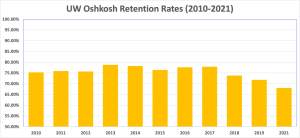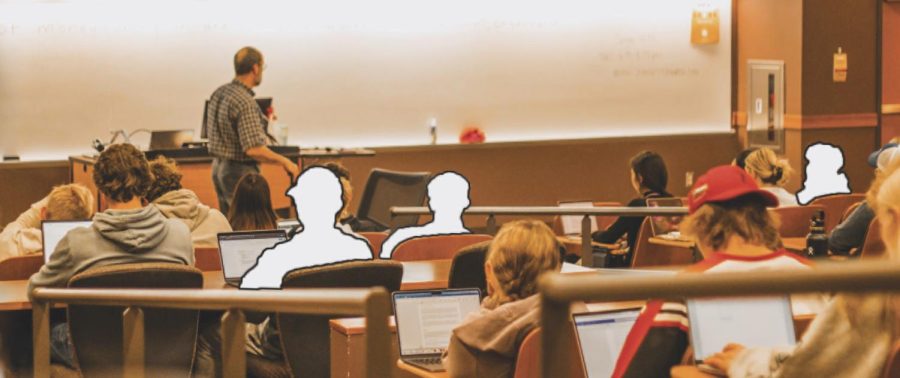UWO works to increase student retention
Photo creds: Charlie Bruecker / The Advance-Titan– Last year’s loss in first-year student retention was 32%. This visual represents a loss of around 1/3 (or 32%) of a class due to poor retention rates.
September 28, 2022
The retention rates for first-year students dropped to a 40-year low at UW Oshkosh last fall, after the pandemic left students in a desperate state both educationally and economically.
Erin Grisham, the UWO vice chancellor for student affairs, oversees all departments that impact students. Her goal is to help students be their best selves.
“Retention is such a complex issue,” Grisham said, reflecting on the past two years of the pandemic.
COVID-19 has left many students struggling with social anxiety and other mental health struggles, Grisham said. The unknown and constant changing of guidelines has led to many choosing to take a break from higher education.
The pandemic has also led to a certain degree of learning loss. Learning loss impacted many first-year students’ grades, causing academic probation or students dropping out, she said.
However, the pandemic isn’t the only factor in lowering retention rates.
“There are a lot of opportunities for high-paying jobs here so we see a lot of what I call ‘swirl,’” Grisham said. “Students start, then they stop, they go work and then they come back. The path to their degree isn’t as straightforward as it used to be.”
Logan Weinert dropped out of UWO after one semester in 2020.
“I chose to drop out because honestly, it wasn’t worth it to stay mentally and financially,” Weinert said. “In some cases I guess I felt supported but I didn’t most of the time.”
Weinert is currently working as a stonemason and is hoping to move out and have a stable job.

In the wake of declining retention rates, UWO administrators have been working to evaluate what the incoming classes need most to feel supported and successful in their first year.
“One important data point in terms of retention is how students perform in their first semester,” Grisham said. “The more we can be proactive and intentional in supporting students, [the more] we will help students persist and retain into their second year.”
Grisham said UWO has hired staff who will work with first-year students from the time they decide to go to UWO.
These staff are called student success navigators. Administrators at UWO worked tirelessly over the summer to get them in place before the fall semester began.
Kathryn Rysticken is a first-year student from Manitowoc.
“My student success navigator has been texting me and telling me some information and asking how I’m doing,” Rysticken said.
She said her navigator has been very helpful in her first-year experience so far.
“She responds quickly to questions and concerns I have,” Rysticken said. “My transition has been pretty smooth.”
Rysticken recalls feeling supported and encouraged in her transition from high school to college.
“We’re hoping that this group will work with the students, be problem solvers [and] get them connected to resources and whatever they might need to be successful,” Grisham said. “I’m very confident that that approach will help us meet students where they are and get them through their first semester.”
UWO currently holds a 68% retention rate for first-year students. Grisham and her team are hoping we can improve that number to between 78% and 80%.
“I know that retention is one indicator of our success, but we do continue to do a really good job graduating students,” Grisham said. “We also have many students transferring and I don’t see those students as a failure in terms of their college career path.”















